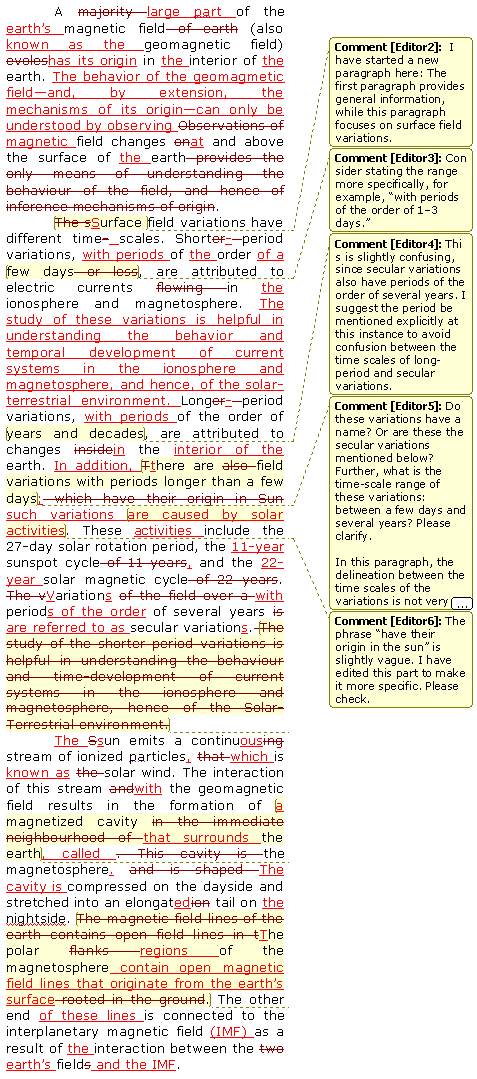A majority of the magnetic field of earth (also geomagnetic field) evoles in interior of earth. Observations of field changes on and above the surface of earth provides the only means of understanding the behaviour of the field, and hence of inference mechanisms of origin. The surface field variations have different time-scales. Shorter period variations, of order few days or less, are attributed to electric currents flowing in ionosphere and magnetosphere. Longer period variations, of the order of years and decades, are attributed to changes inside the earth. There are also field variations with periods longer than a few days which have their origin in Sun. These include the 27-day solar rotation period, the sunspot cycle of 11 years and the solar magnetic cycle of 22 years. The variation of the field over a period of several years is secular variation. The study of the shorter period variations is helpful in understanding the behaviour and time-development of current systems in the ionosphere and magnetosphere, hence of the Solar-Terrestrial environment. The Sun emits a continuing stream of ionized particles that is the solar wind. The interaction of this stream and the geomagnetic field results in the formation of magnetized cavity in the immediate neighbourhood of the earth. This cavity is the magnetosphere and is shaped compressed on the dayside and stretched into an elongation tail on nightside. The magnetic field lines of the earth contains open field lines in the polar flanks of the magnetosphere rooted in the ground. The other end is connected to the interplanetary magnetic field as a result of interaction between the two fields.

A large part of the earth’s magnetic field (also known as the geomagnetic field) has its origin in the interior of the earth. The behavior of the geomagmetic field—and, by extension, the mechanisms of its origin—can only be understood by observing magnetic field changes at and above the surface of the earth.
Surface field variations have different time scales. Short-period variations, with periods of the order of a few days, are attributed to electric currents in the ionosphere and magnetosphere. The study of these variations is helpful in understanding the behavior and temporal development of current systems in the ionosphere and magnetosphere, and hence, of the solar-terrestrial environment. Long-period variations, with periods of the order of years and decades, are attributed to changes in the interior of the earth. In addition, there are field variations with periods longer than a few days; such variations are caused by solar activities. These activities include the 27-day solar rotation period, the 11-year sunspot cycle, and the 22-year solar magnetic cycle. Variations with periods of the order of several years are referred to as secular variations.
The sun emits a continuous stream of ionized particles, which is known as solar wind. The interaction of this stream with the geomagnetic field results in the formation of a magnetized cavity that surrounds the earth, called the magnetosphere. The cavity is compressed on the dayside and stretched into an elongated tail on the nightside. The polar regions of the magnetosphere contain open magnetic field lines that originate from the earth’s surface. The other end of these lines is connected to the interplanetary magnetic field (IMF) as a result of the interaction between the earth’s field and the IMF.
Surface field variations have different time scales. Short-period variations, with periods of the order of a few days, are attributed to electric currents in the ionosphere and magnetosphere. The study of these variations is helpful in understanding the behavior and temporal development of current systems in the ionosphere and magnetosphere, and hence, of the solar-terrestrial environment. Long-period variations, with periods of the order of years and decades, are attributed to changes in the interior of the earth. In addition, there are field variations with periods longer than a few days; such variations are caused by solar activities. These activities include the 27-day solar rotation period, the 11-year sunspot cycle, and the 22-year solar magnetic cycle. Variations with periods of the order of several years are referred to as secular variations.
The sun emits a continuous stream of ionized particles, which is known as solar wind. The interaction of this stream with the geomagnetic field results in the formation of a magnetized cavity that surrounds the earth, called the magnetosphere. The cavity is compressed on the dayside and stretched into an elongated tail on the nightside. The polar regions of the magnetosphere contain open magnetic field lines that originate from the earth’s surface. The other end of these lines is connected to the interplanetary magnetic field (IMF) as a result of the interaction between the earth’s field and the IMF.